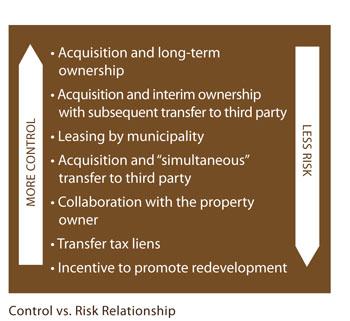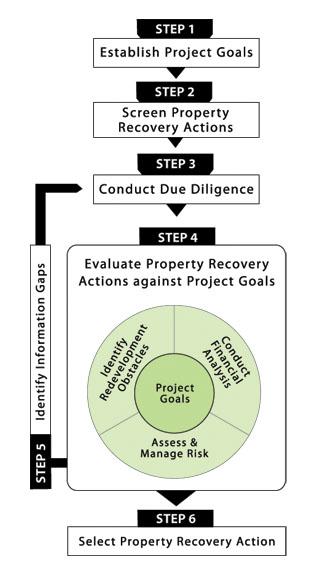PREPARED
Process for Risk Evaluation, Property Analysis and Reuse Decisions
FOR LOCAL GOVERNMENTS CONSIDERING THE REUSE OF CONTAMINATED PROPERTIES
What is the PREPARED Workbook?
The Workbook was developed by EPA New England and its contractors for local governments (it should also be useful to states, counties, tribes and quasi-governmental redevelopment entities). PREPARED is a risk management framework for evaluating various actions that a local government might take to bring about a desired reuse at contaminated properties that it does not currently own. These actions are referred to in the Workbook as property recovery actions. Worksheets are also provided to help document and guide the evaluation process.

What are examples of property recovery actions?
The actions available to local governments include acquisition and non-acquisition approaches. The accompanying figure lists some common property recovery actions that are discussed in the Workbook. In a generalized way, these property recovery actions are organized in descending order of local government control. Often, this control comes with an increased potential for incurring project risk.
What is risk management and why is it important?
Risk management is the art of assessing, at least on a qualitative or comparative level: How likely is an adverse event? What could happen if it occurs? And what can be done to minimize either or both?
Each property recovery action carries its own set of project risks. Identifying and resolving the most significant risks are critical to a successful reuse strategy.
What are project risks?
The Workbook considers three categories of project risk:
Environmental Liability
This can include liability arising from environmental statutes and common law. The Workbook primarily focuses on federal environmental cleanup statutes, including key provisions and policies under which a local government can potentially minimize or avoid liability. Some general discussion of state laws and programs, and common law liability, is also provided.
Having an understanding of the various cleanup statutes and programs also helps local governments assess which ones could apply to a particular property—including when EPA is likely to invoke Superfund authorities. Superfund cleanups actually account for a relatively small percentage of the total universe of sites. As described in the Workbook, amendments made to the Superfund law in 2002 and efforts by EPA to clarify and communicate Superfund liability protections have provided local governments with important tools for understanding and managing potential Superfund liability. Many Superfund sites and other seriously contaminated properties are proving to be excellent candidates for reuse.
Financial Risk
To properly evaluate property recovery actions, local governments should weigh the financial risks and benefits of municipal involvement. This may include estimating the potential costs to the municipality of undertaking a given property recovery action and identifying potential sources of revenue and other funding to implement the project. In addition, having some understanding of the financial viability of potential redevelopment scenarios can help in assessing whether the project goals are realistic and likely to attract private investment. While a detailed discussion of financial analysis is beyond the scope of the Workbook, the Workbook identifies some general factors relating to the environmental conditions that might be appropriate to consider as part of a financial analysis. Also provided is an abbreviated pro forma worksheet that can be used as a rough estimating tool to assess financial viability.
Community Issues
Local community issues can play a central role in the risk management process. Left unaddressed, they may create significant impediments to achieving the project goals. Effective community engagement helps to identify and resolve potential concerns. Furthermore, developers are far more likely to be attracted to an area where the local government and other stakeholders have a demonstrated history of constructive involvement in projects. The Workbook discusses the link between local community issues and project risk, and outlines some important principles for conducting community engagement.
Overview of the PREPARED Approach

The basic steps:
-
Establish realistic and achievable project goals and other key parameters (Chapter 2).
-
Screen-out property recovery actions not likely to achieve the project goals (Chapter 3).
-
Conduct due diligence to obtain relevant property-specific information and to qualify for certain liability protections under the federal Superfund statute (Chapter 4). Due diligence is an essential step in evaluating property recovery actions even if the local government is not planning to take title to the property.
-
Evaluate property recovery actions through an iterative approach:
-
Identify potential redevelopment obstacles (Chapter 5)
-
Assess project risks (Chapters 6, 7, 8 & 9)
-
Assess the project’s costs and financial viability (Chapter 8)
-
Identify risk management tools and approaches (Chapter 10)
-
-
Identify information gaps and prioritize additional information gathering efforts.
-
Select a property recovery action based on the municipality’s sensitivity to the potential risks and other relevant factors (Chapter 11).
